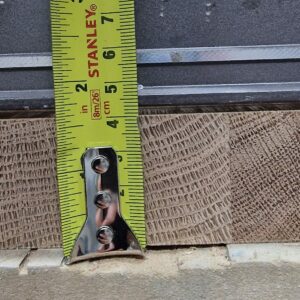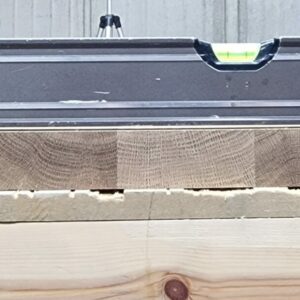Hi,
I’m making a small table for my kitchen and hit a problem after glueing up the oak table top. I had oak ripped to 4x2s at the sawmill, put them in my workshop for a day or so and then glued it all up. After the glue up everything seemed fine, I left it in there for another few days – still fine.
I broke out a hand plane just to flatten the joints a bit before sanding (they wernt that bad and I wish I had just sanded them now in retrospect). Unfortunately the grain in the oak is all over the place so when I planed it, I started to get tear out – which was really frustrating. So I ended up taking more off the table than I had planed to, to get rid of that. Probably only 2 or 3mm total though.
I came back into the workshop a few days ago after having left it for less than a week (to calm down and prepare myself for loads of sanding) and its cupped really badly. It seems mostly to be the two end boards but I really don’t understand what’s happened…
As I understand it, the timber will cup on the side that has less moisture, so if laid flat on the bench that would more then likely be the top side as it’s exposed to the air. My table was laid with the topside down – the side that was planed. And the underside exposed to the air, but its cupped with the concave on the topside – which was flat on the bench.
I know its not good to leave it without being placed on stickers, which I did do before but forgot after being frustrated that I’d just spent an hour planing tearout into the table. But I would’ve expected it to cup in the opposite direction if anything.
So….
Has planing a few mm more off the one side of it caused this? Do you always need to plane an equal amount off both sides?
I checked the moisture content on the end grain as it seems to be the place I can get the prongs in deepest (not sure how reliable this is though) and the boards are around 12%
Another thing I thought about was alternating the end grain on the boards. I tried to do this but found it difficult to determine which was some of them were going as its quite wavy (hopefully you can see from the pics) is there a way to tell when the end drain seems to go in multiple directions?
How do I fix this without cutting it all apart and rejoining it? I’m scared that if I plane it flat again, it’ll just cup again if that’s what caused it to go in the first place. It’s £300 worth of oak so I can’t really afford to scrap it and start again 🤦🏽♂️ it’s currently laid concave side down on my bench and clamped flat. I’ve wiped it with water on that side a few times over the last day or so but nothing seems to be happening.
Any advice would be appreciated. I’m really frustrated with it and not knowing what went wrong or how to avoid it is the worst part.


















Replies
Sticker it and wait. Since you added water wait longer. The side exposed to air took up moisture and expanded, cupping the top. Now that you've wet it you won't know what you actually have until it dries and then reaches equilibrium. It might just return to flat.
If the top is laid concave side down can you push down in the center to get it flat? Just wondering if attaching it to the apron will fix the problem, or if you’re not going to have an apron then using c-channel set in to the top. Maybe it’s too thick to flatten enough without lots of pressure, but I’d give that a try before starting over.
A clamp in the middle has pulled it flat to my bench, so I think it could be pulled down with a C chanel or something similar so that could be an option! I wondered if pulling it flat with mechanical fixings might cause other issues though, as the wood will be under stress and less able to move, or am I over thinking?
I see a 1/8 inch cupping over a 30 inches wide panel, that is not much and you should be able to keep it straight with an apron, it won’t stress the wood but has to allow for wood movement since you have relatively high moisture reading, which might be the cause for the panel cupping.
I think it depends on how much pressure it takes to push it down. That’s why I asked about pushing it rather than clamping. If it doesn’t take extreme pressure to flatten it I’d personally feel ok about using c-channel or some other mechanical option. C-channel and aprons are meant to keep slabs from getting out of flat if the wood wants to cup (resisting the pressure). In your case it would be doing the same thing, resisting the cupping pressure (which is already happening).
Looking at your pictures, it appears that the grain on the two boards on the left are glued in the same direction. If there is further movement it will be in that direction - least amount of resistance. It also looks like you are getting pretty thin (below 3/4”) on the thickness. Be careful with the thickness if you decide on a “C” channel. Like others mentioned, if you plan to put a skirt around the bottom, you may be able to pull it flat. The last option if you have enough width, you can cut along your glue lines, flit the boards and glue it back together. Frankly, if you have enough width, that would be my option. Wood will always move and you have already stressed it, it will move further. Something to consider in the future when working with unfinished wood that has been surfaced - always cover it completely up when leaving it sit without finish.
Uneven milling and 12% moisture is probably the source of the problem. Cupping in a panel made up of narrow boards can be traced to minute angular errors in jointing, but this is immediately apparent.
If the table has an apron the cup will pull out when mounting. Be sure to leave room for movement, as this panel is going to shrink.
The big lessons here:
1) Use cauls, and KEEP THEM ON until it’s fully acclimated or ready to install.
2) Never ever never lay a panel flat on a table without stickers.
3) Orient boards with the grain direction the same (forget about rings up down) or don’t go near it with a hand plane!
Mortise and Tenon Magazine issue 09 has an article “Making an Icon Panel” by Symeon van Donkelaar. In the article he describes a technique for preventing cupping. The Icon panels are made from joined boards and as you discovered these types of construction can sometimes cup. He describes and shows how a pair of tapered dovetail battens are used to maintain a “flat” surface. It’s worth a read if you can find it. Good luck.
I acclimate tabletop stock in the house for a few weeks before milling it. Once milled, the glue-up is done in the shop as quickly as possible and the whole she-bang put back in the house.
A warped top, already at finished thickness with no room to fix, can be a complete bust. It'll pull the table's base into twist when you mount it, or it won't sit flat.
The most important side to be flat, square, and out of twist is the side that will be mounted to the base. The side exposed to the world can be a little out and nobody will ever notice it.
This forum post is now archived. Commenting has been disabled